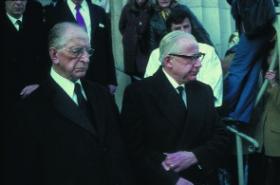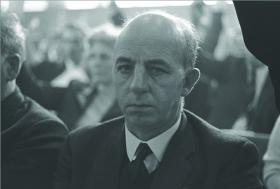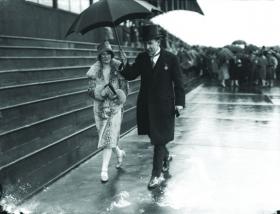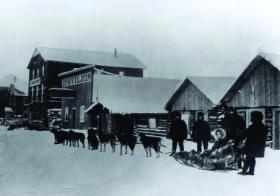TV eye: Hidden History
Published in 20th-century / Contemporary History, Issue 1 (Jan/Feb 2005), Reviews, Volume 13Hidden History
RTÉ1
Family Fortune: de Valera’s Irish Press, 2 Nov 2004
Directed by Gerry Nelson for Mint Productions
Joe Cahill, IRA man, 7 Dec 2004
Directed by Jonathon Golden for DoubleBand Films
by Eamon O’Flaherty

On his retirement as taoiseach in 1959, Eamon de Valera installed his son Vivion (right) as head of the Irish Press companies. At a single stroke they had been effectively transferred to the de Valera family. (RTÉ Stills Library)
RTÉ’s Hidden History series offered an impressive collection of documentaries before Christmas. The focus was heavily biographical—Women of the Klondike, a study of Irish women in the Gold Rush of the early 1900s, a new look at Kevin O’Higgins’s life and a biography of Joe Cahill. The Irish Press documentary was dominated by the figure of Eamon de Valera. Biographies are always appealing; their human focus makes them attractive and accessible, and they offer an easy way into an understanding of historical periods and controversies. Biography also has its limitations as a tool of historical explanation. The individual subject can dominate the scene, and the background and context offered can often be rather conventional. But when skilfully handled, a biographical approach seems uniquely suited to the popular mission of televisual history, especially when the editing process allows the subject to be viewed from a variety of perspectives. Both films reviewed here had a topical as well as a historical dimension. The strange twilight existence of the Irish Press companies lingers on, despite the continuing protests of remaining shareholders and former employees. The recurrent crisis of the Northern Ireland peace process was illuminated by the Cahill documentary, which tried to put the evolution of the process in some perspective via a study of Cahill’s career.
Family Fortune highlighted some important recent research on the de Valera family’s role in the control of the Irish Press, much of it the work of Mark O’Brien. An analysis of surviving documents and interviews with surviving shareholders revealed the way in which de Valera set up and maintained control of the Irish Press in the 1920s. The Press was set up to provide Fianna Fáil with a mouthpiece as part of its decision to re-enter constitutional politics after 1926. To finance the paper, a fund-raising campaign was initiated in Ireland and the US. Shares were sold in two companies: the Irish Press Ltd, based in Ireland, and the Irish Press Corporation, in the United States. Buying shares was seen as a patriotic act on both sides of the Atlantic, but in America the shares were also advertised as an investment.

Joe Cahill in 1971. The key point of the documentary was the analysis of his role in supporting the decision to adopt a political strategy in the mid-1980s, leading to the cease-fire of 1994 and the Good Friday Agreement. (RTÉ Stills Library)
Both aims were to be disappointed in time. De Valera’s obsession with ensuring that he controlled the Press led to an extraordinary corporate arrangement. The American shares were divided into ‘A’ and ‘B’ shares. The A shares were subscribed by the investors to the tune of $300,000. Only the B shares, all of which were bought by de Valera for $1,000, had any voting rights. Dev then used his control of the American funds to purchase a controlling interest in the Irish company that actually ran the Press. The result was that none of the other shareholders had any control—nor were any dividends paid until the 1970s. On his retirement as taoiseach in 1959, de Valera installed his son Vivion as head of the company. At a single stroke the company had been effectively transferred to the de Valera family. The newspapers have long since closed and the employees been sacked amid bitter acrimony. Some angry and determined shareholders still protest annually at the company AGM but are outvoted, because the controlling interest resides with the heirs to de Valera’s arrangement. It seems a poor reward for the idealism of those who financed the Press in the 1920s and those journalists and printers who worked to build up the assets of the group over six decades.
Apart from the secret history of its finances and ownership structure, the Press was a successful aspect of Fianna Fáil’s constitutional shift in the 1920s. Joe Cahill, IRA man looked at a more recent constitutional shift in Irish politics that, over ten years after the 1994 ceasefire, is still uncertain and in constant crisis. Born in West Belfast in 1920, Joe Cahill spent his life as an IRA activist. Sentenced to death for his part in the murder of a policeman in 1942, Cahill was reprieved but his friend and comrade Tom Williams was hanged. Released from prison in 1949, Cahill was again in jail during the shambolic IRA border campaign of 1956–62. During the leftward shift of the IRA leadership under Cathal Goulding, Cahill became disillusioned with the direction of the Republican movement, which came to a head during the outbreak of the conflict in the North in 1969 and the split between Provisionals and Officials. Cahill was one of the architects of the Provisional IRA—effectively a takeover by Ulster militants supported by Southern diehards—and its increasingly violent strategy of armed struggle and indiscriminate bombing.

Two other ‘Hidden History’ documentaries (not reviewed here) concerned Kevin O’Higgins, pictured here with his wife at the Dublin Horse Show, and Women of the Klondike, involved in the Gold Rush of the early 1900s. (RTÉ Stills Library)
The key point of the documentary was the analysis of Cahill’s role in supporting the decision to adopt a political strategy in the mid-1980s, leading to the ceasefire of 1994 and the Good Friday Agreement. The complete ascendancy of the Ulster militants was reflected in the departure of the remaining abstentionist diehards in 1986, but Cahill, it is argued, was the key to winning the support of the Provisional IRA veterans and prisoners for the Adams strategy. One may wonder whether part of the selling process involved the cultivation of unrealistic expectations in the IRA itself about its future role.
What made him tick? Eamonn McCann gave the most convincing account of Cahill as essentially a pragmatist, viscerally loyal to the Republican movement as the defender of the Northern Catholic community. Neither the ‘bohemian’ radicalism of the Official leadership of the 1960s nor the impossiblist dedication to the old shibboleths of abstentionism by the Ó Brádaigh faction after 1986 were allowed to take precedence over the IRA’s tribal role in Northern Ireland politics. One of the many interesting questions that remains to be answered is whether a strategy born out of the Northern conflict and tribal politics can effect the transition to national constitutional politics with any success, or whether Cahill’s heirs are saddled with a militant wing that refuses to leave the stage. Despite some longueurs, this was an interesting account of a life, much of which was lived in secret. For those of us who lived through those turbulent times, it was interesting to see the wealth of archival footage that was banned from TV screens under the broadcasting regulations of the 1970s and 1980s, one of the minor dividends of a fragile peace.
 Eamon O’Flaherty lectures in history at University College Dublin.
Eamon O’Flaherty lectures in history at University College Dublin.
















